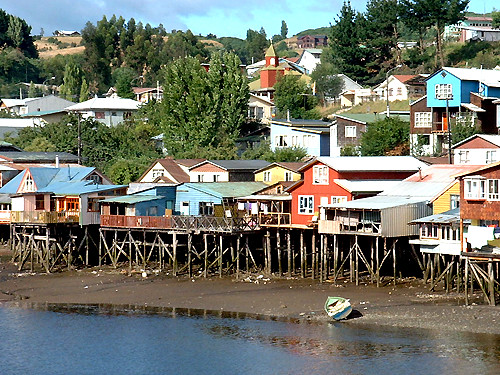Castro (Chile)
Castro is a city in the south of the South American Andean country with 39 876 inhabitants Chile (calculated 2010). It is the capital of the second largest island of the country, Chiloé, in the Región de los Lagos.
Geography
The city is located approximately in the middle of the island of Chiloe, about 164 km south of Puerto Montt. Through the city leads the Panamericana.
The climate is mild, but very moist.
In December and January can be translated to Chaiten on the continental side from Castro with a car ferry.
History
Castro is the third oldest city in Chile, which has been inhabited continuously since its founding. Before the Spaniards already the people of the Huilliche lived on Chiloé. In 1540 Alonso de Camargo explored from the coastlines of the island from the ship. Enter the first time the island was November 8, 1553 by Francisco de Ulloa. Castro was founded on February 12, 1567 by the Spanish captain Martín Ruiz de Gamboa. The city, which in 1594 already 8,000 inhabitants - the majority Farmer - counted was plundered by the middle of the 17th century several times by Dutch pirates and destroyed in 1837 by an earthquake.
The capital city status on Chiloe Castro lost when laying the government to Ancud (1788 ). 1907 lived only 1243 inhabitants in the city. 1912 Castro received a rail connection to the city of Ancud, which led to an economic boom. When the Great Chile Earthquake on May 22, 1960 Castro was badly damaged. The station and the railway line to Ancud were destroyed and never rebuilt. The town hall of the city and many of the houses on stilts were the earthquake and subsequent tsunami victims. At the time of the earthquake of 1960 Castro had 7000 inhabitants. Not until 1982 that Castro was again the capital of the island.
Economy
Castro lives mainly from tourism, fishing and agriculture.
Attractions
- As well as the wooden churches in the districts RiLAN, Nercon and Chelin 2000 together with others on the island in the - in the Plaza de Armas with its well-maintained gardens, the center of Castro, the main church of the city, the Iglesia de San Francisco, which rises world heritage Site by UNESCO was taken. Already in 1567 there was a first church on this site. The current 1910-12 after a fire in Neo-Gothic style by the Italian architect Eduardo Provasoli newly constructed building is 52 m long and 27 m wide, the largest church building in the entire island. The two towers of the 1997-99 renovated church - the fourth at this point - 42 m high and visible from afar.
- Famous are also the palafitos called stilt houses of the fishermen on the coast, which are obtained mainly in the western city of Barrio Gamboa at bay Fiordo de Castro, and in the north east of the city on the coast road Calle Pedro Montt. Many of these stilt houses fell the earthquake of 1960 and the subsequent tsunami victims.
- In the Barrio Gamboa district is also a chapel in the style of palafitos worth seeing.
- Below the city of Castro is a shipyard to be built in the fishing boats imd traditional style. From here you can enjoy a nice view of the lake dwellings of Gamboa.
- An artisan market ( Fería de Artesania ) south of the port provides plenty of choice for tourists.
- The Regional Museum (Museo Regional de Castro) by Castro provides testimonies from the time of Huillichen and information about the history of the Spanish colonization of Castro.
- Also worth visiting the Museum of Modern Art, founded in 1988 Chiloé is (Museo de Arte Moderno de Chiloé ).
- Not far north of the port was on the former station site, the Plazuela del Tren, a small park created. Here a locomotive and other rolling stock of the railway line were set up, which ended up to 1960 at this point.
- Once a year in the third week of February, a large folk festival is held, the festival Costumbrista.
- Another wooden church, which was declared a UNESCO World Heritage Site, is in 2007 eingemeindeten Nercon district, about 5 km south of the city center. It bears the name Iglesia Nuestra Señora de Gracia and was built in 1886-90 mainly from the wood of coihue southern beech, whose wood does not rot in the humid climate of Chiloé. Outside the church is a well-kept garden was laid out, and behind it spreads the cemetery of the village of Nercon, which existed in 1627 and 1734 already had a chapel at this point. The 27 july 1984 National cultural monument declared church is 37.3 meters long and 15.3 meters wide, its tower reaches a height of 25.36 m.
- Between Nercon Castro and a small shipyard, boats are made from larch wood, and a small votive chapel are worth seeing at the bridge over the river Nercon.
Environment
The fjord landscape is ideal for hiking. West of Castro is the National Park of Chiloé. South of the small town Chonchi lies with the well-known summer festival Fiesta Criolla, which takes place in mid-February. On the weekend of celebrations the city head and hundreds of people is flowing into the normally quiet town by the sea.
Transport links
From Castro from good bus links into all areas of the island of Chiloe, as well as to Puerto Montt and Valdivia in the Chilean mainland. Since 2012, the city Castro also has an airport offering three weekly flights to Santiago de Chile with the airline LAN.










